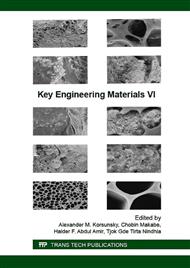[1]
H. Onoe, S. Takeuchi, Cell-laden microfibers for bottom-up tissue engineering, Drug Discovery Today. 20 (2015) 236-246.
DOI: 10.1016/j.drudis.2014.10.018
Google Scholar
[2]
M.G. Yeo, G.H. Kim. Cell-printed hierarchical scaffolds consisting of micro-sized polycaprolactone (PCL) and electrospun PCL nanofi bers/cell-laden alginate struts for tissue regeneration, J. Mater. Chem. B. 2 (2014) 314-324.
DOI: 10.1039/c3tb21163k
Google Scholar
[3]
R. Levato, J. Visser, J.A. Planell, et al. Biofabrication of tissue constructs by 3D bioprinting of cell-laden microcarriers, Biofabrication. 6 (2014) 035020.
DOI: 10.1088/1758-5082/6/3/035020
Google Scholar
[4]
N.N. Kachouie, Y.A. Du, H. Bae, et al. Directed assembly of cell-laden hydrogels for engineering functional tissues, Organogenesis. 6 (2010) 234-244.
DOI: 10.4161/org.6.4.12650
Google Scholar
[5]
A.A. Adebiyi, M.E. Tasli, K.D. Crawford. The use of computational fluid dynamic models for the optimization of cell seeding processes, Biomaterials. 32 (2011) 8753–8770.
DOI: 10.1016/j.biomaterials.2011.08.028
Google Scholar
[6]
C. Ye, Z.X. He, Y.F. Lin, et al. Bio-electrospraying is a safe technology for delivering human adipose-derived stem cells, Biotechnology Letters. 37 (2015) 449-456.
DOI: 10.1007/s10529-014-1693-0
Google Scholar
[7]
S.N. Jayasinghe. Bio-electrosprays: from bio-analytics to a generic tool for the health sciences, Analyst. 136 (2011) 878–890.
DOI: 10.1039/c0an00830c
Google Scholar
[8]
Y.M. Ma, Y.Y. Liu, H.P. Chen, et al. Application and Analysis of Biological Electrospray in Tissue Engineering, Open Biomedical Engineering Journal. 9 (2015) 133-137.
Google Scholar
[9]
E. Ayad, T.N. Andrea, J.F. Timms, et al. Molecular characterisation of post-bio-electrosprayed human brain astrocytoma cells, Analyst. 135 (2010) 2600–2612.
DOI: 10.1039/c0an00213e
Google Scholar
[10]
B. Kerol, M. Napachanok, S.N. Jayasinghe, et al. The differentiation and engraftment potential of mouse hematopoietic stem cells is maintained after bio-electrospray, Analyst. 135 (2010) 157–164.
DOI: 10.1039/b917813a
Google Scholar
[11]
D.I. Braghirolli, F. Zamboni, P.C. Chagastelles, et al. Bio-electrospraying of human mesenchymal stem cells: An alternative for tissue engineering, Biomicrofluidics. 7 (2013) 128-147.
DOI: 10.1063/1.4819747
Google Scholar
[12]
D. Greig, S.N. Jayasinghe. Genomic, genetic and physiological effects of bio-electrospraying on live cells of the model yeast Saccharomyces cerevisiae, Biomedical Materials. 3 (2008) 034125.
DOI: 10.1088/1748-6041/3/3/034125
Google Scholar
[13]
S. Sambit, L.W. Cheng, G.J.C. Hong, et al. Bio-Electrospraying: A Potentially Safe Technique for Delivering Progenitor Cells, Biotechnology and Bioengineering. 106 (2010) 690–698.
DOI: 10.1002/bit.22734
Google Scholar
[14]
A. Abeyewickreme, A. Kwok, J.R. McEwan, et al. Bio-electrospraying embryonic stem cells: interrogating cellular viability and pluripotency, Integrative Biology. 1 (2010) 260-266.
DOI: 10.1039/b819889f
Google Scholar


